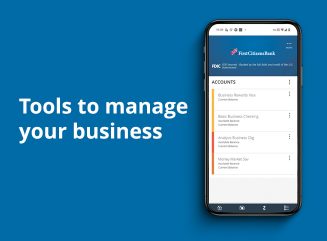
Digital banking for business
Seamlessly access all of your accounts from one place with First Citizens Digital Banking for business.
The benefits of a college education can last a lifetime. In a competitive job market, a college degree is an essential requirement for many positions. From that first job, and throughout their careers, college graduates are better prepared for professional growth opportunities—and greater career earnings potential.

Unfortunately, the cost of a college education grows more expensive each year. Even with student loans, financial grants, work-study programs and current income availability, families continue to depend on personal savings as their college-funding cornerstone.
The harsh reality is that many students and families lack sufficient financial resources and are forced to incur significant debt.
In the 2021-2022 school year, the College Board estimates the average in-state cost of one year at a four-year public college is $22,690. The average cost for a year at a private four-year college is estimated to be $51,690—and many schools cost substantially more.
Historically, estimates of annual college expense increases with inflation have ranged from 3% to 6%. Recently, new estimates have shown college tuition increasing annually at 8%. Here's an estimate of future educational costs based on recent data, an annual tuition increase of 8% and an average annual 5% inflation rate of other college-related costs.
|
Year |
4-year Public College |
4-year Private College |
|---|---|---|
|
2021/2022 |
$22,690 |
$51,690 |
|
2022/2023 |
$24,147 |
$55,417 |
|
2023/2024 |
$25,702 |
$59,421 |
|
2024/2025 |
$27,363 |
$63,724 |
|
2025/2026 |
$29,137 |
$68,349 |
|
2026/2027 |
$31,032 |
$73,320 |
|
2027/2028 |
$33,057 |
$78,664 |
|
2028/2029 |
$35,221 |
$84,410 |
|
2029/2030 |
$37,535 |
$90,588 |
|
2030/2031 |
$40,008 |
$97,231 |
Source: College Board, Trends in College Pricing 2021
The best way to build a college fund is to start saving money today. Then, save as much as you can, whenever you can and for as long as you can.
Regular, methodical savings—combined with raises, tax refunds and unexpected financial windfalls—can build a significant college fund over time. Here's how a monthly deposit can grow over the years.
|
Monthly Deposit |
5 years |
10 years |
15 years |
|---|---|---|---|
|
$100 |
$6,977 |
$16,388 |
$29,082 |
|
$400 |
$20,931 |
$49,164 |
$87,246 |
|
$500 |
$34,885 |
$81,940 |
$145,409 |
Table assumes an average after-tax return of 6%. Actual results will vary. All investing involves risk, including the possible loss of principal. There is no guarantee that any investing strategy will be successful.
The first step is to evaluate the different savings options available now. Each of these plans is proven and currently used by thousands of families and students. Here's an overview and comparison of plan requirements, options, and features:
Tax breaks, donor control, low maintenance and broad availability
Contributions to a tax-advantaged 529 plan accumulate on a tax-deferred basis. Withdrawals are tax-free at the federal level if the money is used for qualified educational expenses. States also offer similar tax advantages. Withdrawals not used for qualified expenses are subject to income tax and a 10% federal penalty.
There's no income limit to participate. Lifetime contribution levels are $350,000 and up, with limits varying by state. In 2022, super-funding is possible—up to $80,000 for individual gifts and $160,000 for joint gifts—with no gift tax implications if requirements are met. The availability and features of 529 plans vary by state.
Tax-advantaged savings plus donor control
The Coverdell education savings account, or ESA, is also tax-advantaged, allowing up to $2,000 in contributions per year for a beneficiary's K-12 or college expenses. Contributions grow tax-deferred and earnings are tax-free at the federal level if the money is used for qualified educational purposes. One key difference between this and a 529 plan is a 529 may offer tax advantages for contributions, while contributions to a Coverdell ESA are not tax deductible.
With a Coverdell ESA, the donor controls investments in the account, subject to income restrictions on participation.
Flexibility, irrevocable gifts, custodial control
Custodial accounts, regulated under the Uniform Transfers to Minors Act (UTMA) or the Uniform Gift to Minors Act (UGMA), allow a minor to hold investments in their own name, with an adult custodian. Contributions to the account are irrevocable gifts and assets can (but are not required to) cover college expenses. At age 18 or 21, depending on the state, the child assumes complete control of the account. Earnings and capital gains are taxed under the "kiddie tax" rules.
Fund with after-tax dollars, tax-free growth and withdrawals
While not technically a college savings program, a Roth IRA is also a viable option. Funded with after-tax dollars, money can be withdrawn tax-free at any time. For parents 59 1/2 and older, earnings can be withdrawn tax-free if the account has been open for 5 years or more. For parents younger than 59 1/2, earnings withdrawn early are taxable, but no tax penalty is enforced if the funds are used for college expenses.
Based on need and ability
Many families depend on financial aid—loans, grants, scholarships and work study—to make college a reality. Financial aid based on need requires a review of income and family factors such as assets and other children in college. Retirement assets, primary home equity, life insurance policies, certain family businesses and personal property are not counted in the financial review.
Most college websites include a net price calculator to help parents estimate how much financial aid might be available to them.
When it comes to saving for college costs, time can be a friend or foe. With enough time, a significant amount can be accumulated through a regular savings plan. With too little time available, realistic savings growth opportunities diminish.
Make sure time is on your side. Plan ahead, develop a savings strategy, calculate costs and understand funding options. Most of all, start today because college isn't getting less expensive.
Email Us
Please select the option that best matches your needs.
Customers with account-related questions who aren't enrolled in Digital Banking or who would prefer to talk with someone can call us directly.